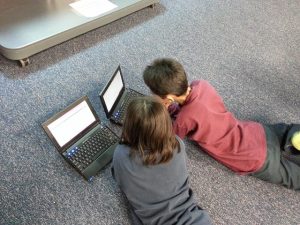Virtual Reality is an incredible tool. Its ability to put the viewer in a first person perspective on anything can lead to amazing journeys without leaving a classroom, and the ability to play around with concepts in a safe and controlled environment can help show more of how things work without Health and Safety concerns.
The technology has been gaining speed in recent years thanks to the falling price and accessibility, as well as the growing interest. With several price points for entry there are so many options available, and with that comes plenty of educational value.

From Google Cardboard and virtual reality hire, to buying into the high-end headsets such as the HTC Vive and Oculus Rift, there’s an entry mark for any budget.
Having all the technology to hand is one thing, but how can we use VR to actually educate children? With a little thought, there are so many options already available that in some circumstances it can be hard to see how the classroom managed beforehand.
Some concepts are very difficult to portray to children. The sheer scale of the solar system, for example, is difficult to show through 2d imagery alone. We all remember seeing the pictures in textbooks, but can we really wrap our heads around the actual reality? Using virtual reality, there’s no need to struggle with that. Kids can don the headsets and see, first hand, just how large these planets really are.
Sounds unreal? Plenty of apps already exist for this purpose, such as Titans of Space VR, though there are other free options available. Many of these apps are also free, giving children diversity in the classroom without breaking the budget.
VR can also be used to portray other complicated concepts, such as evolutionary paths or scientific theories. Examples have been made with apps that let children play with the concepts, hands on. This can really help crack the issue between knowing the theories, and understanding them, giving a real depth to the lessons going forward and helping the information stick.
Biology can especially benefit from this, with 3d models of parts of the body being viewable from all sorts of angles easily for an entire class, giving them a unique perspective otherwise hard to show in the classroom environment.
This idea of transporting people to different places is one VR excels at. Virtual field trips are great ways to travel across the world for History trips, such as taking a tour of battlefields across Normandy to explore the events of the Second World War. With diary entries from soldiers on the front lines readable as students wander around the field giving more context, it turns the experience from difficult to connect to a very real and personal understanding.
Google is leading the way in this field with their extensive Google Expeditions app, available for both VR and the up and coming augmented reality platforms that are gaining speed. Options vary from Geography and cultural trips to locations around the world to the International Space Centre, and the virtual reality runs on the cheap and cheerful Google Cardboard platform. All this needs to run is any old smart phone, and an easy to make headset that hardly breaks the bank.

Teaching kids about prehistoric times can be brought properly to life with VR, thanks to apps like Oculus’ Jurassic World. In fact, bringing children back to the middle of historical events is a fantastic option.
Or, to put a new spin on it, why not use the technology to teach children how to create the content? Some of the schools in Carlow, Ireland is recreating historic sites as part of their curriculum, for example. This not only gives the students a new look into the events that unfolded at those sites, but it also teaches them the new skills that are rising in demand in the world, preparing them for work down the line.
In fact, the ability to use VR for creation is another great strength in helping bring new ways to educate and expand children’s minds. 3d modelling and content creation are exciting fields rising, helped along by teaching architecture with 3D modelling.
Coding is another strong point of current education that is greatly improved thanks to VR, with concepts demonstrable immediately through the headsets. Students can code certain objects to behave in certain ways and see the feedback right away.
Perhaps the best gift VR can give education is the ability to spark the imagination. By showing all these factors in a new light, kids and adults alike have their minds opened to all the possibilities. Setting their brains on the path to think outside the box will set them up for years to come, and if virtual reality can inspire like that, then it is worth every penny.

